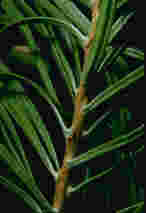
Foliage [C.J. Earle]. |
Abies concolor
(Gordon & Glendinning) Hildebrand 1861
Common NamesWhite fir, balsam fir, silver fir, white balsam (3), Colorado white fir (1), Rocky Mountain white fir (4), pino real blanco (6).Taxonomic notesSyn: Picea concolor Gordon & Glendinning 1858 (6). A. lowiana is often treated as a variety of A. concolor ." Abies concolor is a western catchall species for firs with green seed cones and with glaucous adaxial leaf surfaces. Many of these populations have long been isolated geographically and genetically. A geographic cluster of populations in Utah has shorter leaves and slightly different terpene patterns than a similar cluster of populations in Colorado and northern New Mexico (7, 8). Another large geographic cluster, in southern New Mexico and Arizona, seems to be strongly linked chemically to Colorado populations (8) and morphologically to southern California populations (9). Northern California populations with pubescent twigs and notched leaves are unique, as are the Baja California populations with very short, thick leaves and about 18 adaxial stomatal rows. In Los Padres National Forest of coastal southern California and in the Cascades of northern California, apparent introgression with A. lowiana (8, 9) has occurred. Many consider A. lowiana (given specific rank in this treatment) as a synonym of A. concolor or place it in an infraspecific rank under that species" (6). DescriptionTrees to 40 m tall and 90 cm dbh; "crown spirelike. Bark gray, thin, smooth, with age thickening (to 18 cm) and breaking into deep longitudinal furrows, often revealing yellowish inner periderm, appearing "corky." Branches diverging from trunk at right angles, the lower often spreading and drooping in age; twigs mostly opposite, glabrous or with yellowish pubescence. Buds exposed, either yellowish and nearly conic (when large) or brownish and nearly globose (when small), resinous, apex rounded to pointed; basal scales equilaterally triangular, glabrous, not resinous, margins entire, apex sharp-pointed. Leaves 1.5-6 cm × 2-3 mm, mostly 2-ranked, flexible, proximal portion ±straight; cross section flat, sometimes slightly grooved adaxially; odor pungent, frequently camphorlike; abaxial surface glaucous, with 4-7 stomatal rows on each side of midrib; adaxial surface grayish green, glaucous, with (7)12(18) stomatal rows at midleaf, these usually fewer toward leaf apex; apex usually rounded, sometimes acute or notched; resin canals small, near margins and abaxial epidermal layer. Pollen cones at pollination ± red, purple, or ± green. Seed cones cylindric, 7-12 × 3-4.5cm, olive-green, sessile, apex round; scales ca. 2.5-3 × 3-3.5 cm, pubescent; bracts included. Seeds 8-12 × 3 mm, body tan; wing about twice as long as body, tan with rosy tinge; cotyledons 5-7. 2 n =24" (6).RangeUSA: Idaho, Oregon, California, Nevada, Utah, Colorado, New Mexico, Arizona; Mexico: Baja California Norte, Sonora; at 1700-3400 m in conifer forests (6). Occurs in both pure and mixed stands on rocky, mountain soils (4). See also (11).Big TreeHeight 43 m, dbh 184 cm, crown spread 15 m; in Uinta National Forest, UT (5).OldestAges of >300 years are cited in (10). The ITRDB tree-ring chronology CA513 spans 1596-1968, 372yrs, and is presumably derived from live-tree material.DendrochronologySeen in Oregon, Nevada, Utah, Baja California Norte. Forms extraordinary old growth forests with Pinus lambertiana in the Sierra San Pedro Martír of Baja California Norte.EthnobotanyObservationsRemarksThe name " concolor " refers to the fact that both upper and lower needle surfaces are the same color. The winged seeds provide food for songbirds and small mammals; deer eat the foliage, and porcupines the bark (4).Citations(1) Silba 1986 .(2) Fowells 1965 . (3) Peattie 1950 . (4) Little 1980 . (5) American Forests 1996 . (6) Richard S. Hunt at the Flora of North America web site . (7) Wright et al. 1971 . (8) Zavarin et al. 1975 . (9) Hamrick & Libby 1972 . (10) Burns & Honkala 1990 . (11) Robert S. Thompson, Katherine H. Anderson and Patrick J. Bartlein. 1999. Atlas of Relations Between Climatic Parameters and Distributions of Important Trees and Shrubs in North America. U.S. Geological Survey Professional Paper 1650 A&B. URL= http://greenwood.cr.usgs.gov/pub/ppapers/p1650-a/pages/conifers.html .
See also:
|
|
[ Abies ] [ Pinaceae ] [ home ]
This page is from the Gymnosperm Database
|